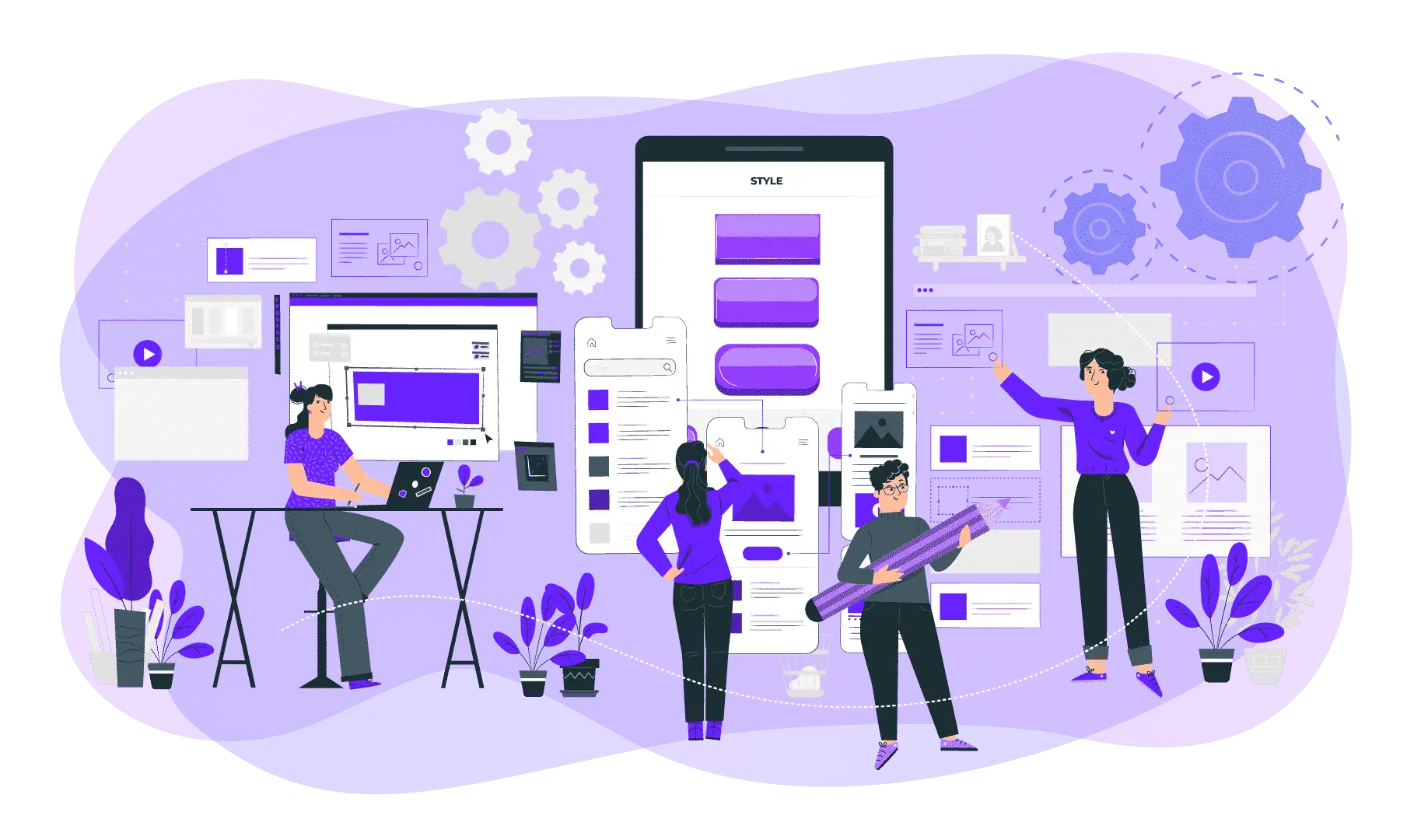Website is one of the most important assets for your business. Your website is like the introduction of your business to your customers. It must feel like a warm cup of hot cocoa on cold winter mornings for your customers. It must be welcoming and easy to navigate.
Your business’s website plays a crucial role in your overall success. You must ensure that it serves its purpose. That is to make your customer feel welcomed and push them towards taking action (making a purchase decision).
The Role of UI/UX Design
If you’re wondering how you can make sure that your website does that, then you’re at the right place. You can make sure your website serves its purpose by focusing on the UI/UX design of your website.
Yes you can do SEO and create engaging content, which is important, but that’ll only bring the customer to your website. What makes your customer stay on your website long enough to make a purchase, is its easy to navigate and user friendly design.
UI/UX design plays an important part in the web design process. Without it, your website is incomplete. Without proper UI/UX design, your website will never be able to convert your audience into loyal customers.
But what is UI/UX design and how can it help your website serve its purpose? Read on and you’ll know.
What is UI/UX Design?
1- UI Design
The aesthetic component of the website is the focus of user interface design. That is, how people use and interact with the website. UI designers focus on things like:
- the contents arrangement, or layout
- the hues
- The typefaces
- the symbols
- elements of navigation
Every aspect of this needs to align with the brand’s identity, and the individual components need to match one another. Therefore, the aim of UI designers is to produce an interface that is visually appealing, simple to use, and easy for the user to navigate. The UI design handles the aesthetic elements that draw users in and direct them to the content on the website that either piques their interest or meets their needs.
2- UX Design
The entire website user experience is encompassed by the more comprehensive User Experience design. Usability, accessibility, and ease of use are top priorities for UX designers.
This entails designing logical workflows, making sure the website is responsive—that is, it functions on a variety of devices—and optimizing the browsing experience. Ensuring that the website is user-friendly and fulfills user needs is the primary objective. A few of the fundamental ideas of UX design are as follows:
1- User Lookup. Research is done by UX designers to comprehend user requirements and behavior. Data analysis, surveys, and interviews may be a part of this.
2- Information planning. UX designers establish the information architecture of a product, including navigation and content organization.
3- User Movement. The route a user will take while using the product is specified by UX designers. This ought to be simple and intuitive.
4- Testing and Usability. Usability testing is a tool used by UX designers to find issues and enhance user experience. Tests with actual users may be a part of this.
5- Availability. A key component of UX design is making sure the product is usable by everyone, including those with disabilities.
The Relation Between UI and UX Design
When building a website, UI and UX design work together closely. For instance, a UX designer ensures that a navigation button is positioned logically and has intuitive functionality, while a UI designer handles the button’s graphic and visual design. Together, they produce a dependable and interesting experience.
The following succinctly describes a few of the primary variations:
- Visual presentation and appearance are the main focus of UI design. It addresses a website’s graphic design.
- Usability, research, and overall user experience are the main priorities of UX design. That is, how consumers engage with and utilize the product.
Now that we’ve talked about the difference between UI and UX design, let’s take a deeper look into the role they play in web development.
UI/UX Design In Web Development

It is impossible to exaggerate how crucial it is to create outstanding user experiences and simple interfaces. The key to creating websites that successfully engage and captivate users is UX/UI design. Here’s how UI/UX design for your website can help captivate your users and leave a lasting impression.
1- Leave A Lasting Impression
You might have heard that first impressions are important. This not only applies to your personality but also to your brand’s image. But how can you make sure that your brand leaves a lasting impression the very first time customers interact with them?
You can leave a lasting impression through effective UI/UX design. A well designed user interface is what creates an aesthetically pleasing and professional look for your website. It is important because it makes your brand more trustworthy in the eyes of your customers. This forces users to spend more time on your website, ultimately leading to higher conversions.
2- Seamless User Experience
Effective UI/UX design guarantees that your website offers a seamless user experience. Intuitive navigation is critical for a seamless user experience. It is because, through intuitive navigation, users can easily find whatever they are looking for on your website. This streamlines the entire buying process for the users.
UI/UX design elements like clear menus, logical layouts, and accessible information architecture helps users navigate the site effortlessly. Leading to an increase in user satisfaction by improving the overall usability of the website.
3- Visual Design Elements Matter
Visual design elements in a UI/UX web design such as color schemes, typography, and imagery are crucial for keeping users engaged. UI/UX designers make sure these design elements remain consistent throughout the website. This makes the user feel more comfortable and familiar with the interface.
4- Responsive Web Design
There are 6 billion smartphone users worldwide, and if you add personal computers, tablets, and iPads to the list, this number rises significantly. This shows that your users can be accessing your website from multiple electronic devices with different screen sizes.
Your website must be able to seamlessly adapt to multiple screen sizes for a seamless user experience. You can make sure that your website is highly responsive through effective UI/UX design. Responsiveness will help increase user satisfaction and improve retention rates.
5- User Centric Approach
Understanding the user needs is a crucial part of the UX in web design. UI/UX designers can create user personas by conducting user research to understand the users better. This helps tailor the user experience according to their needs. This helps foster deeper connections with the users and promotes loyalty among them.
The user centric approach also demands you focus more on mobile first designs.
Mobile First Designs
Studies show that 50% of the users using a brand app are more likely to make a purchase from that brand.
This makes mobile first designs a priority for brands looking to scale and promote loyalty among users. If you are looking to do the same, then you must focus on the following mobile app design trends;
1- Augmented & Virtual Reality
Augmented and virtual reality technology is crucial for creating more immersive experiences for your users. This makes it crucial for UI/UX designers and web developers to explore these technologies. You must invest in these technologies if you want your customers to keep coming back for more.
2- Adaptability
Users are now continuously switching from one device to another, like from phone to laptop or a smart watch. They expect apps to be accessible and synchronized with all their devices. This means that designing an app for only a single device may become a thing of the past in the near future.
3- Neumorphism
Neumorphism is a UI/UX design trend that is used to create visual elements that appear 3d-ish. It is done by using subtle shadows and color palettes to create elements that appear embedded within the background.
This trend enhances the overall user experience and gives your digital product (mobile app) a unique visual appeal.
4- AI Incorporation
AI enhances user experiences by noting user behavior and then suggesting them the products they are most likely to be interested in. AI chatbots are also high in demand, as they assist users in their buying journey making the overall buying experience seamless.
Designers must take this AI obsession into consideration, whenever designing a mobile app.
We Can Help!
If you are looking for long-term success in the digital space, then it is time for you to make a wise move and contact us. Our expert UI/UX designers and web developers will make sure you get a website that not only attracts but also increases conversions.


